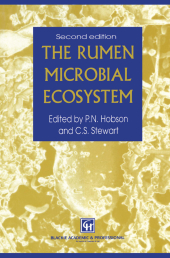 Neuerscheinungen 2012Stand: 2020-01-07 |
Schnellsuche
ISBN/Stichwort/Autor
|
Herderstraße 10
10625 Berlin
Tel.: 030 315 714 16
Fax 030 315 714 14
info@buchspektrum.de |

P. N. Hobson, C. S. Stewart
(Beteiligte)
The Rumen Microbial Ecosystem
Herausgegeben von Hobson, P.N.; Stewart, C.S.
2. Aufl. 2012. xxii, 719 S. 235 mm
Verlag/Jahr: SPRINGER NETHERLANDS; SPRINGER, BERLIN 2012
ISBN: 9401071497 (9401071497)
Neue ISBN: 978-9401071499 (9789401071499)
Preis und Lieferzeit: Bitte klicken
The Preface to the first edition of this book explained the reasons for the publication of a comprehensive text on the rumen and rumen microbes in 1988. The microbes of the ruminant´s forestomach and those in related organs in other animals and birds provide the means by which herbivorous animals can digest and obtain nutriment from vegetation. In turn, humans have relied, and still do rely, on herbivores for much of their food, clothing and motive power. Herbivores also form the food of carnivorous animals and birds in the wild. The importance of the rumen microorganisms is thus apparent. But, while a knowledge of rumen organisms is not strictly neces sary for the normal, practical feeding of farm animals, in recent years there has been much more emphasis on increasing the productivity of domesti cated animals and in rearing farm animals on unusual feedstuffs. Here, a knowledge of the reactions of the rumen flora, and the limits to these reactions, can be invaluable. In addition, anaerobic rumen-type microor ganisms are found in the intestines of omnivores, including humans, and can be implicated in diseases of humans and animals. They are also found in soils and natural waters, where they playa part in causing pollution and also in reducing it, while the same organisms confined in artificial systems are essential for the purification of sewage and other polluting and toxic wastes.
Introduction. Rumen bacteria. Rumen anaerobic fungi. Protozoa. Development of, and natural fluctuations in, rumen microbial populations. Energy yielding and consuming reactions. Metabolism of nitrogen-containing compounds. Polysaccharide degradation. Lipid metabolism. Genetics of rumen bacteria. Microbe-microbe interactions. Compartmentation. Manipulation of rumen fermentation. Toxin degradation. Modelling. Gnotobiotics. Conclusions. References. Index.


